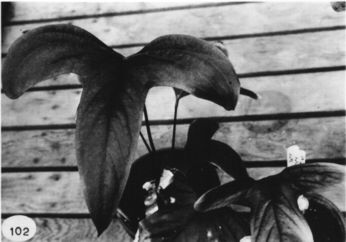




TYPE: Panama. Colón: along road between Portobelo and Nombre de Dios, 1.2 mi. beyond the junction of road to Isia Grande, 79°35'W, 9°40'N, Croat 49792 (MO 2886024, holotype; F, K, NY, PMA, US, VEN, isotypes; Live at MO).
Terrestrial; stems 1-1.5 cm diam.; leaf scars obscured by roots and persisting cataphylls; roots moderately thin, descending; cataphylls moderately thick, 4.5-7 cm long, drying brown, splitting at the base, the apex persisting intact, ultimately deciduous.
LEAVES erect-spreading; petioles 14-57 cm long, flattened adaxially to weakly sulcate; geniculum 1-1.5 cm long, more conspicuously sulcate; blades subcoriaceous, 3-lobed, acuminate at apex, shallowly lobed to more or less rounded at base, (14-)20-44 cm long, 24-42 cm wide, broadest between base and midway from the outermost points of the lateral lobes; anterior lobe 20-44 cm long, 5-9(-18) cm wide, the margins convex; lateral lobes 13-27 cm long, 3-9.5 cm wide, usually falcate; sometimes extended at right angles to anterior lobe; both surfaces matte, the lower surface drying conspicuously paler; midrib narrowly and acutely raised above, convexly raised below with 1 or 2 ribs, these sometimes extending onto genicu-lum; basal veins 5-8 pairs, the first, sometimes second free to the base, third to sixth or seventh coalesced to 8 cm, the lowermost 1-2 coalesced to 4 cm, prominulous above, raised below; primary lateral veins 6-8 per side, departing midrib at 25-30° angle, acutely raised above, raised below, more or less straight to collective vein; lesser veins conspicuous above and below, flat above, prominulous below; collective vein of median lobe arising from one of the primary lateral veins, flat to scarcely sunken above, raised below, 3-5 mm from the margin.
INFLORESCENCE usually erect; peduncle terete, 17-38 cm long, 4ų5 mm diam.; spathe subcoriaceous, green, lanceolate, 9.5-12 cm long, 1-1.5 cm wide, acuminate at apex, acute at base; stipe 3-7 mm long; spadix usually green, sometimes pale yellow, 6-14 cm long, 5-6 mm diam. at base, 2-3 mm diam. at apex; flowers weakly 4-lobed (dried), 2-2.8 mm long, 1.5-2.5 mm wide, the sides sigmoid, 6-7 flowers visible in the principal spiral, 7-8 flowers visible in the alternate spiral; lateral tepals 0.6-0.7 mm wide, the inner margin convex; pistils scarcely emergent; stamens probably not exsert-ed at anthesis, pollen white.
INFRUCTESCENCE not seen. Fig. 102.
Anthurium impolitum is known for certain only from Panama in tropical wet forest at 150 to 900 m from Colón to Darien east of the Canal. It is a member of section Semaeophyllium and is characterized by its generally terrestrial habit, its matte (thus its name impolitum meaning unpolished), prominently three-lobed leaf blades with a prominent naked posterior rib, and by its green to yellow-green, long-tapered spadix and oblong-lanceolate green spathe. The species is perhaps most closely related to Anthurium cineraceum, but that species differs in having thicker blades that generally dry gray-ish rather than greenish or yellowish green as in A. impolitum. Anthurium cineraceum lacks a naked posterior rib and generally has longer more pointed lateral lobes. It is known only from Colombia and adjacent areas of Panama near the Colombian border.
Anthurium impolitum occurs with A. garagaranum in Colón Province of Panama near sea level but they can be distinguished even in sterile condition, the former being terrestrial with short internodes and matte, scarcely bicolorous blades, and the latter being a climber with the lower internodes elongate and glossy, having distinctly bicolorous blades.
A collection from the headwaters of the Río Tuquesa in Darien Province of Panama (Croat 27116) differs in having the lateral lobes less well developed, and it is placed in Anthurium impolitum with reservations.
Although herbarium material seems quite uniform, live material displays some vague vegetative variations. Further study of live material in flower may uncover two distinct species. Live plants of Croat 49126 and 53541, included as Anthurium impolitum, appear to have somewhat thicker, less veiny blades.

Map of Mesoamerican specimens with coordinates
Panama Colón: 09.40N 79.35W, , Thomas B. Croat 49792 (F, K, MO, NY, PMA, US,
VEN).
Panama Colón: Cerro Jefe Region,, 31 Jan. 1971, Thomas B. Croat 13208 (MO).
Panama Colón: Cerro Bruja, 860 m,, 18 May 1978, Hammel 3147 (MO).
Panama Colón: Cerro Jefe Region, 600-700 m,, 9 Mar. 1979, Hammel & D'Arcy
6366 (MO).
Panama Darien: Río Tuquesa,, 25 Aug. 1974, Thomas B. Croat 27116 (MO).
Panama Darien: 600-800 m, 8.05N 77.16W, 24 Oct 1987, B. Hammel G. de Nevers,
H. Cuadros & H. Herrera 16480 (MO).
Panama Panamá: 450 m, 09.18N 79.59W, 3 April 1993, Thomas B. Croat 75134 (MO).
Panama Panamá: 325-350 m,, 17 July 1987, Croat 67396 (B, MO).
Panama Panamá: 450 m, 9.14N 79.00W, 6 July 1982, Knapp 5934 (MO).
Panama Panamá: 150-400 m,, 5 May 1973, Kennedy et al. 3134 (MO).
Panama Panamá: 350 m,, 5 Dec. 1979, Thomas B. Croat 49126 (MO).
Panama Panamá: Cerro Jefe Region, 600 m,, 12 June 1976, Thomas B. Croat 35935
(MO).
Panama San Blas: 350 m, 09.20N 79.00W, 20 July 1994, Thomas B. Croat & Guanghua
Zhu 77003 (MO).
Panama San Blas: 550 m, 9.44N 78.68W, 14 March 1985, Thomas B. Croat 60491 (MO).
Panama San Blas: 300-350 m, 9.15N 79.00W, 12 July 1988, Thomas B. Croat 69287
(MO).
Panama San Blas: 350 m,, 10 May 1981, Sytsma & Andersson 4480 (MO).
Panama San Blas: 350-400 m,, 10 May 1981, Sytsma & Andersson 4513 (MO, PMA).
Panama San Blas:, 20 Apr. 1981, Croat 53541 (MO).
Panama San Blas: 65 m, 09.22N 78.34W, 11 Aug 1994, Galdames, C. et al. 1550
(STRI).
Panama San Blas: 65 m, 09.22N 78.34W, 11 Aug 1994, Galdames, C. et al. 1560
(STRI).